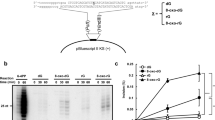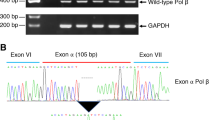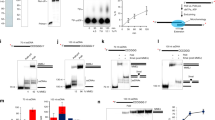Abstract
p53 exhibits 3′-5′ exonuclease activity and the significance of this biochemical function is currently not defined. In order to gain information about the potential role(s) of this exonuclease activity, recombinant and wild-type human p53 was examined for excision of nucleotides from defined synthetic DNA substrates. p53 removes nucleotides threefold faster from single-strand DNA than from DNA duplexes, exhibits a 1.5-fold preference for 3′-terminals of DNA that contain a single nucleotide mispair (mismatch) as compared to correctly paired DNA and efficiently excises nucleotides from 3′-ends of blunt and cohesive (staggered) DNA double-strand breaks. The p53 exonuclease is predominantly non-processive on DNA which is 17 nucleotides long (or shorter) and processive on the longer 30-mers. The processivity of nucleotide excision is decreased in the presence of 50 mM potassium phosphate and eliminated when full-length p53 is replaced with the core domain, comprised of amino acids 82–292. Photoaffinity labeling indicates that (1) p53 monomers, rather than dimers, bind to single-strand forms of these oligomers; (2) complexes between p53 and 30-mers are more stable than those formed with 17-mers. The stability of these complexes determines processivity during nucleotide removal and modulates the 3′-5′ exonuclease activity of p53. The relevance of substrate specificity of the p53 exonuclease to DNA repair is discussed.
This is a preview of subscription content, access via your institution
Access options
Subscribe to this journal
Receive 50 print issues and online access
$259.00 per year
only $5.18 per issue
Buy this article
- Purchase on Springer Link
- Instant access to full article PDF
Prices may be subject to local taxes which are calculated during checkout






Similar content being viewed by others
References
Albrechtsen N, Dornreiter I, Grosse F, Kim E, Wiesmuller L and Deppert W. . 1999 Oncogene 18: 7706–7717.
Arrowsmith CH and Morin P. . 1996 Oncogene 12: 1379–1385.
Bakalkin G, Selivanova G, Yakovleva T, Kiseleva E, Kashuba E, Magnusson KP, Szekely L, Klein G, Terenius L and Wiman KG. . 1995 Nucl. Acids Res. 23: 362–369.
Belyakova NV, Kleiner NE, Kravetskaya TP, Legina OK, Naryzhny SN, Perrino FW, Shevelev IV and Krutyakov VM. . 1993 Eur. J. Biochem. 217: 493–500.
Bryant PE and Liu N. . 1994 Int. J. Radiat. Biol. 66: 597–601.
Bullock AN, Henckel J, DeDecker BS, Johnson CM, Nikolova PV, Proctor MR, Lane DP and Fersht AR. . 1997 Proc. Natl. Acad. Sci. USA 94: 14338–14342.
Butcher S, Hainaut P and Milner J. . 1994 Biochem. J. 298: 513–516.
Chu G. . 1997 J. Biol. Chem. 272: 24097–24100.
Chuang YY, Chen Q, Brown JP, Sedivy JM and Liber HL. . 1999 Cancer Res. 59: 3073–3076.
Davison TS, Yin P, Nie E, Kay CC and Arrowsmith CH. . 1998 Oncogene 17: 651–655.
Dudenhoffer C, Rohaly G, Will K, Deppert W and Wiesmuller L. . 1998 Mol. Cell. Biol. 18: 5332–5342.
El-Deiry WS, Tokino T, Velculescu VE, Levy DB, Parsons R, Trent JM, Lin D, Mercer WE, Kinzler KW and Vogelstein B. . 1993 Cell 75: 817–825.
Griffiths SD, Clarke AR, Healy LE, Ross F, Ford AM, Hooper ML, Wyllie AH and Greaves M. . 1997 Oncogene 14: 523–531.
Gottlieb TM and Oren M. . 1996 Biochim. Biophys. Acta 1287: 77–102.
Hansen S, Lane DP and Midgley CA. . 1998 J. Mol. Biol. 275: 575–588.
Harper JW, Adami GR, Wei M, Keyomarsi K and Elledge SJ. . 1993 Cell 75: 805–816.
Hoss M, Robins P, Naven TJP, Pappin DJC, Sgouros J and Lindahl T. . 1999 EMBO J. 18: 3868–3875.
Huang P. . 1998 Oncogene 17: 261–270.
Insdorf NF and Bogenhagen DF. . 1989 J. Biol. Chem. 264: 21498–21503.
Janus F, Albrechtsen N, Knippschild U, Wiesmuller L and Grosse F and Deppert W. . 1999a Mol. Cell. Biol. 19: 2155–2168.
Janus F, Albrechtsen N, Dornreiter I, Wiesmuller L, Grosse F and Deppert W. . 1999b Cell. Mol. Life. Sci. 55: 12–27.
Kamiya K, Huang P and Plunkett W. . 1996 J. Biol. Chem. 271: 19428–19435.
Kastan MB, Onyekwere O, Sidransky D, Vogelstein B and Craig RW. . 1991 Cancer Res. 51: 6304–6311.
Kolesnikov VA, Zinoviev VV, Yashina LN, Karginov VA, Baclanov MM and Malygin EG. . 1981 FEBS 132: 101–104.
Kuhn C, Muller F, Melle C, Nasheuer H-P, Janus F, Deppert W and Grosse F. . 1999 Oncogene 18: 769–774.
Kukhanova M, Liu S-H, Mozzherin D, Lin T-S, Chu C-K and Cheng Y-C. . 1995 J. Biol. Chem. 270: 23055–23059.
Kunkel TA. . 1985 J. Biol. Chem. 260: 5787–5796.
Lalumiere M and Richardson CD. . 1995 Baculovirus Expression Protocols. Richardson CD. (ed.) Humana Press: Totowa, New Jersey pp. 161–177.
Lee S, Elenbaas B, Levine A and Griffith J. . 1995 Cell 81: 1013–1020.
Loeb LA and Cheng KC. . 1990 Mut. Res. 238: 297–304.
Mazur DJ and Perrino FW. . 1999 J. Biol. Chem. 274: 19655–19660.
Mummenbrauer T, Janus F, Muller B, Wiesmuller L, Deppert W and Grosse F. . 1996 Cell 85: 1089–1099.
Nicholas AL and Young CSH. . 1994 Mol. Cell. Biol. 14: 170–180.
Nishino H, Knoll A, Buettner VL, Frisk CS, Maruta Y, Haavik J and Sommer SS. . 1995 Oncogene 11: 263–270.
Okorokov AL, Ponchel F and Milner J. . 1997 EMBO J. 16: 6008–6017.
Pelicano H, Kukhanova M, Seow H and Cheng YC. . 1998 Proc. Am. Cancer Assoc. 39: 28.
Perrino FW and Loeb LA. . 1989 J. Biol. Chem. 264: 2898–2905.
Rogers SG and Weiss B. . 1980 Methods Enzymol. 65: 201–211.
Selivanova G, Iotsova V, Kiseleva E, Strom M, Bakalkin G, Grafstrom RC and Wiman KG. . 1996 Nucl. Acids Res. 24: 3560–3567.
Shevelev IV, Kravetskaya TP, Legina OK and Krutyakov VM. . 1996 Mutat. Res. 352: 51–55.
Skalski V, Chang CN, Dutschman G and Cheng Y-C. . 1993 J. Biol. Chem. 268: 23234–23238.
Skalski V, Liu S-H and Cheng Y-C. . 1995 Biochem. Pharm. 50: 815–821.
Sobol RW, Horton JK, Kuhn R, Gu G, Singhal RK, Prasad R, Rajewsky K and Wilson SH. . 1996 Nature 379: 183–186.
Tarunina M and Jenkins JR. . 1993 Oncogene 8: 3165–3173.
Umar A and Kunkel TA. . 1996 Eur. J. Biochem. 238: 297–307.
Vaziri H, West DM, Allsopp RC, Davison TS, Wu Y-S, Arrowsmith CH, Poirier GG and Benchimol S. . 1997 EMBO J. 16: 6018–6033.
Zu L and Halligan BD. . 1999 Biochem. Biophys. Res. Comm. 259: 262–270.
Acknowledgements
The authors are grateful to Dr CH Arrowsmith for providing the core domain of p53, Dr S Benchimol for polyclonal antibody to p53 and Dr CD Richardson for full-length p53. The authors also wish to thank Dr Arrowsmith, Dr Benchimol, Dr H Klamut and Dr AM Rauth for their helpful comments and critical review of the manuscript and M Harris-Brandts for her valuable technical advice. V Skalski dedicates this work to Teresa Skalski. This work was supported by start-up funds received by V Skalski from the Princess Margaret Hospital Foundation.
Author information
Authors and Affiliations
Rights and permissions
About this article
Cite this article
Skalski, V., Lin, ZY., Choi, B. et al. Substrate specificity of the p53-associated 3′-5′ exonuclease. Oncogene 19, 3321–3329 (2000). https://doi.org/10.1038/sj.onc.1203649
Received:
Revised:
Accepted:
Published:
Issue Date:
DOI: https://doi.org/10.1038/sj.onc.1203649
Keywords
This article is cited by
-
The exonuclease activity of hPMC2 is required for transcriptional regulation of the QR gene and repair of estrogen-induced abasic sites
Oncogene (2011)
-
Exonucleolytic degradation of RNA by p53 protein in cytoplasm
Journal of Molecular Medicine (2008)
-
p53 in recombination and repair
Cell Death & Differentiation (2006)
-
Nonhomologous end-joining of site-specific but not of radiation-induced DNA double-strand breaks is reduced in the presence of wild-type p53
Oncogene (2005)
-
P53 in cytoplasm may enhance the accuracy of DNA synthesis by human immunodeficiency virus type 1 reverse transcriptase
Oncogene (2004)



